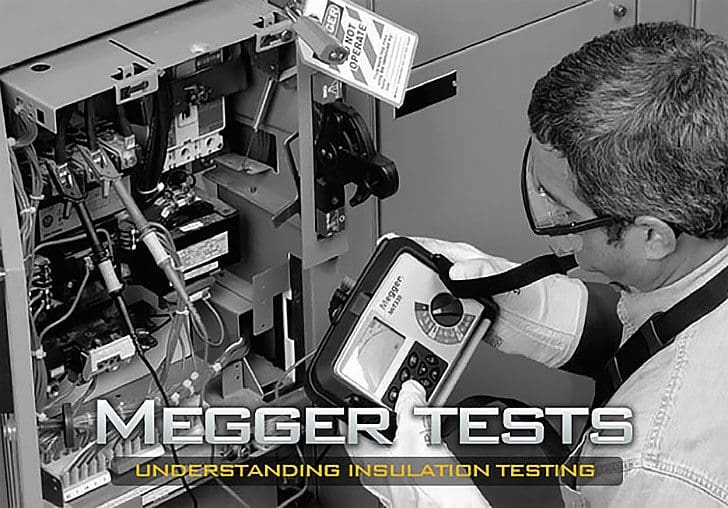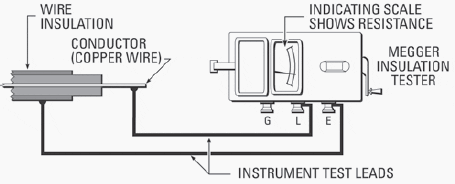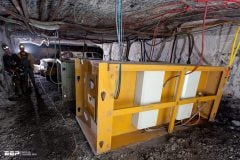Good Insulation Resistance?
As you know good insulation has high resistance and poor insulation relatively low resistance. The actual resistance values can be higher or lower, depending upon such factors as the temperature or moisture content of the insulation (resistance decreases in temperature or moisture).

With a little record-keeping and common sense, however, you can get a good picture of the insulation condition from values that are only relative.
The Megger insulation tester is a small, portable instrument that gives you a direct reading of insulation resistance in ohms or megohms. For good insulation, the resistance usually reads in the megohm range.
The Megger insulation tester is essentially a high-range resistance meter (ohmmeter) with a built-in direct-current generator. This meter is of special construction with both current and voltage coils, enabling true ohms to be read directly, independent of the actual voltage applied.
This method is non-destructive; that is, it does not cause deterioration of the insulation.

The generator can be hand-cranked or line-operated to develop a high DC voltage which causes a small current through and over surfaces of the insulation being tested (Fig. 2). This current (usually at an applied voltage of 500 volts or more) is measured by the ohmmeter, which has an indicating scale.
Fig. 3 shows a typical scale, which reads increasing resistance values from left up to infinity, or a resistance too high to be measured.
What is “Good” Insulation?
Every electric wire in your plant – whether it’s in a motor, generator, cable, switch, transformer, etc. – is carefully covered with some form of electrical insulation. The wire itself is usually copper or aluminum, which is known to be a good conductor of the electric current that powers your equipment. The insulation must be just the opposite from a conductor: it should resist current and keep the current in its path along the conductor.
To understand insulation testing you really don’t need to go into the mathematics of electricity, but one simple equation – ohm’s law – can be very helpful in appreciating many aspects. even if you’ve been exposed to this law before, it may be a good idea to review it in the light of insulation testing.
Purpose of megger test
The purpose of insulation around a conductor is much like that of a pipe carrying water , and ohm’s law of electricity can be more easily understood by a comparison with water flow. In Figure 1 we show this comparison. Pressure on water from a pump causes flow along the pipe (Fig. 1a). If the pipe were to spring a leak, you’d waste water and lose some water pressure. With electricity, voltage is like the pump pressure, causing electricity to flow along the copper wire (Fig. 1b).
As in a water pipe, there is some resistance to flow, but it is much less along the wire than it is through the insulation.

Common sense tells us that the more voltage we have, the more current there’ll be. Also, the lower the resistance of the wire, the more current for the same voltage. Actually, this is ohm’s law, which is expressed this way in equation form:
e = I x R
where,
e = voltage in volts
I = current in amperes
R = resistance in ohms
Note, however, that no insulation is perfect (that is, has infinite resistance) so some electricity does flow along the insulation or through it to ground. Such a current may only be a millionth of an ampere (one microampere) but it is the basis of insulation testing equipment. note also that a higher voltage tends to cause more current through the insulation.
This small amount of current would not, of course, harm good insulation but would be a problem if the insulation has deteriorated. now, to sum up our answer to the question “what is ‘good’ insulation?”
We have seen that, essentially, “good” means a relatively high resistance to current. Used to describe an insulation material, “good” would also mean “the ability to keep a high resistance.” So, a suitable way of measuring resistance can tell you how “good” the insulation is. Also, if you take measurements at regular periods, you can check trends toward its deterioration (more on this later).
What Makes Insulation Go Bad?
When your plant electrical system and equipment are new, the electrical insulation should be in top notch shape. Furthermore, manufacturers of wire, cable, motors, and so on have continually improved their insulations for services in industry. nevertheless, even today, insulation is subject to many effects which can cause it to fail – mechanical damage, vibration, excessive heat or cold, dirt, oil, corrosive vapors, moisture from processes, or just the humidity on a muggy day.
In various degrees, these enemies of insulation are at work as time goes on – combined with the electrical stresses that exist. As pin holes or cracks develop, moisture and foreign matter penetrate the surfaces of the insulation, providing a low resistance path for leakage current.
Once started, the different enemies tend to aid each other, permitting excessive current through the insulation. Sometimes the drop in insulation resistance is sudden, as when equipment is flooded. Usually, however, it drops gradually, giving plenty of warning, if checked periodically. Such checks permit planned reconditioning before service failure.
If there are no checks, a motor with poor insulation, for example, may not only be dangerous to touch when voltage is applied, but also be subject to burn out. What was good insulation has become a partial conductor.
Resource: Megger handbook











Our house had a lightening strike and we need some one to do a Mega Meter test. We are inWilmington North Carolina, the name of a local company that can do the test would be great. Thanks
make some calls to local contractors. Just ask. Better than leaving comments here.
A ring main unit connected to a 315kVA transformer until recently has its fuses starting to blow. what will be the possible cause for the blown fuses?
@Emma- fuses blow when there is too much current.
Gentlemen,
How often the electrical system should have megger test done?
There is no regulation so we may follow the public experiences but how long?
Thanks,
Daniel
We want digital insulation tester make magger.
Firstly: I am not employed by, and have no connection with, the company owning the ‘Megger’ trade-name.
Megger is only one of several leading makes of insulation tester, but there are others just as good. Owing to the long history of that manufacturer, the word is often used as a generic name for any tester that contains an internally generated high-voltage DC source combined with resistance-measuring circuitry. The earlier testers had an analog scale (i.e. a mechanical meter movement) and a hand-cranked generator. However the later models, regardless of who manufactures them, normally have a solid-state DC source and a digital display. They often provide a selectable test voltage, typically 100, 250, 500, & 1000v.
An instrument with higher voltage output e.g. 2.5 or 5kV, and correspondingly higher resistance ranges (G-ohms) would certainly be more expensive – partly because it’s manufactured in much smaller numbers – and it isn’t likely to include a 500v range (which is by far the most commonly specified test condition for LV installations).
Regarding test voltage: This is often dictated by external regulations, but if not, then as a general principle it should be not less than the maximum peak voltage that the circuit will be subjected to – normally 110% of the nominal RMS voltage x root 2.
When the test shows that the insulation resistance is low, how to discover where, exactly, the defect is located?
Reply to Joseph,
Yes, there’s a serious risk of an insulation breakdown. You’re applying a voltage more than eight times the intended PEAK working voltage. In this case the designer has evidently sized the insulation very conservatively, but you can’t assume that it will always survive. A safer -and entirely satisfactory- DC test value for the 433v wiring would be 1kV – but this would probably mean using a different instrument; most 5kV testers cannot be adjusted to such a level.
@N. MIYAKOSHI you can’t.
normally you should disconnect circuit and test it separately.
I feel happy to know about electrical system
With reference documents please help me out….
Hi Every one,
Please give the solution for my question,
I was working for RGPL, one question was raised her regarding concerte coating Megger test value does any one know what was the acceptance value of Ohms for concerte coating for Gas Pipe line.
We are using 5kv megger for testing HV side and LVside (433v)
Is there is any chance of problem for the insulation
What should be the applied dc voltage for insulation test?
For e.g. the primary delta connected wingdings are rated at 6.6kV phase to phase, and we test for insulation between phase to ground, then what should be the applied voltage between the phase and ground? Which rule defines the value of applied voltage for such test?
hello I am peruvian i need information about standar electric IEC and nema.
thank you
I have years on-off ON Eletrical Engineering in Universidade Severino Sombra, RJ
confirm the test method of insulation resistance on busboot with detailed reference of applicable standard.